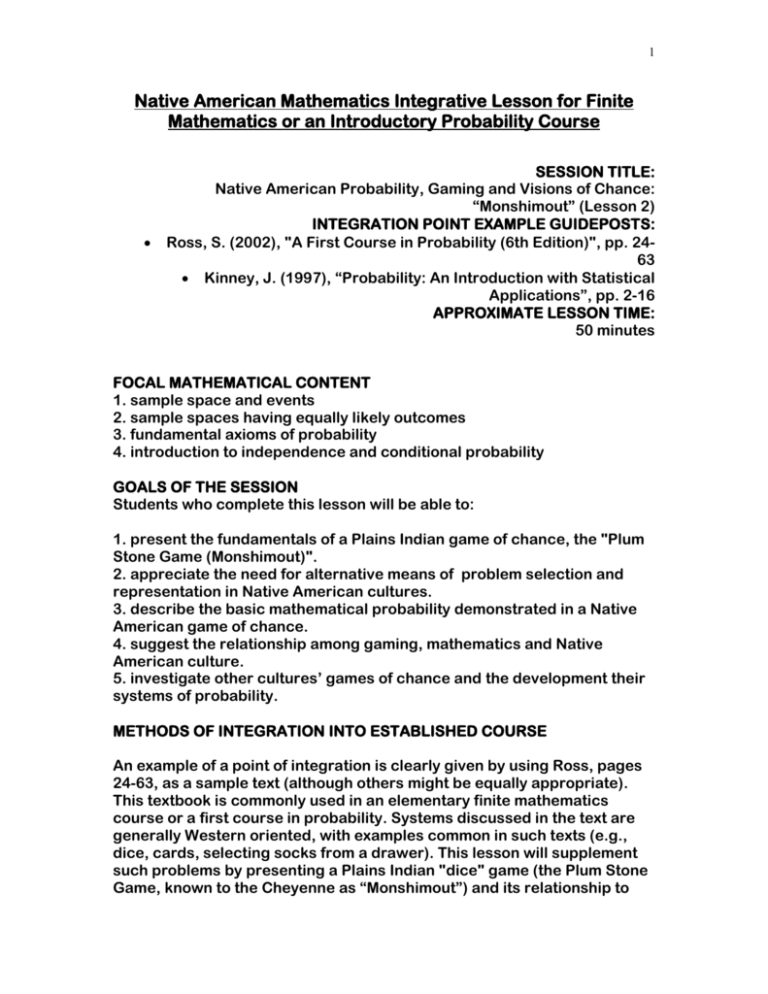Native American Mathematics Integrative Lesson for Finite
advertisement

1 Native American Mathematics Integrative Lesson for Finite Mathematics or an Introductory Probability Course SESSION TITLE: Native American Probability, Gaming and Visions of Chance: “Monshimout” (Lesson 2) INTEGRATION POINT EXAMPLE GUIDEPOSTS: Ross, S. (2002), "A First Course in Probability (6th Edition)", pp. 2463 Kinney, J. (1997), “Probability: An Introduction with Statistical Applications”, pp. 2-16 APPROXIMATE LESSON TIME: 50 minutes FOCAL MATHEMATICAL CONTENT 1. sample space and events 2. sample spaces having equally likely outcomes 3. fundamental axioms of probability 4. introduction to independence and conditional probability GOALS OF THE SESSION Students who complete this lesson will be able to: 1. present the fundamentals of a Plains Indian game of chance, the "Plum Stone Game (Monshimout)". 2. appreciate the need for alternative means of problem selection and representation in Native American cultures. 3. describe the basic mathematical probability demonstrated in a Native American game of chance. 4. suggest the relationship among gaming, mathematics and Native American culture. 5. investigate other cultures’ games of chance and the development their systems of probability. METHODS OF INTEGRATION INTO ESTABLISHED COURSE An example of a point of integration is clearly given by using Ross, pages 24-63, as a sample text (although others might be equally appropriate). This textbook is commonly used in an elementary finite mathematics course or a first course in probability. Systems discussed in the text are generally Western oriented, with examples common in such texts (e.g., dice, cards, selecting socks from a drawer). This lesson will supplement such problems by presenting a Plains Indian "dice" game (the Plum Stone Game, known to the Cheyenne as “Monshimout”) and its relationship to 2 the probability concepts taught in an introductory finite mathematics or probability course in U.S. colleges and universities. MULTIPLE REPRESENTATIONS 1. Drawings 2. Videos or photographs of Native Americans playing the Plum Stone Game 3. Models of Plum Stone dice and possible outcomes for the game 4. Students using Native American gaming in varied situations SESSION-RELATED QUESTIONS FROM THE STUDENTS OR INSTRUCTOR 1. Instructor-generated questions about probability and games of chance. 2. Instructor-generated questions about Plains Indian culture and life related to games and chance, and the need for mathematically representing and communicating about them. 3. Student-generated questions about games of chance. 4. Student-generated questions about Plains Indian culture and their mathematical uses of gaming. 5. All questions generated will be recorded for further discussion and investigation in this lesson and future lessons. IMBEDDED ASSESSMENT OPPORTUNITIES These include but are not limited to 1. session activities in which participants are presented with an example of probability and chance related Plains Indian culture, and are asked to analyze, interpret or respond to the example. 2. students will present an example of Plains Indian gaming to one another. 3. students will devise similar systems of gaming and be able to explain the motivation and mathematical basis for the systems. 4. students will create written, pictorial, CD ROM or video representations of their games. 5. students will complete assigned problems from Ross (or a similar text) and a supplemental worksheet related to Plains Indian mathematical probability utilized in the Plum Stone Game. SESSION-RELATED STUDENT OR INSTRUCTOR STORIES The story is as important as the content. Stories are oral or written ways of relating a particular idea or concept to the real world or everyday life, to a broader context than just the abstract content. Native American students (and teachers) will be more familiar with this concept than non- 3 Native Americans, so this skill may take some practice for the latter group. The instructor will collect his own stories and those of students in class related to the learning of games of chance and specific information related to Native American culture and its mathematics. This session is developed for an audience of undergraduate mathematics students, both Native American and non-Native American. It also will include mathematics education and non-mathematics education students. Stories should, therefore, be of use and interest to this diverse audience. A. INSTRUCTOR MATERIALS Print Materials/Transparencies/Media Narrative on history, mathematics and sociology of Native American gaming and the Plum Stone Dice Game in particular (see Narrative which follows lesson) Transparency diagram, “Plum Stone Game”, from Monshimout Narrative (see graphic in Narrative) PowerPoint Presentation, “NA Materials Lesson No.2 PPT” (optional) Equipment Overhead and blank transparencies Plum Stone dice set Bowl or basket Cameras or videocam/VCR Opaque projector B. PARTICIPANT MATERIALS Print Materials: Group Work Diagram, “Plum Stone Game" (see A “Instructor Materials” above) Print Materials: Individual Work Worksheet on “Plains Indian Probability” (see Activity #1 below) Equipment Plum Stone dice set Bowl or basket (Digital) Camera or videocam\VCR “PowerPoint” on PC or Mac CD burner and appropriate software C. SESSION OVERVIEW Ross, C. 2, "Axioms of Probability” (or comparable text) presented as suggested in text or as usually presented by the instructor 4 After the section sample spaces with equally likely outcomes, student knowledge and interest in traditional gaming and Plains Indian culture will be investigated PowerPoint Presentation, “NA Materials Lesson No.2 PPT” (optional) History of Plum Stone Game presented Plains Indian gaming graphic presented and methods demonstrated Students attempt and practice Plains Indian Plum Stone Dice Game Mathematical content (e.g., outcomes, sample space, probability of outcomes) discussed Students generate own gaming systems and explain the mathematics behind them Students told to investigate other Native American games and present them in the next class Problems assigned both from Ross (pp. 53-58) (or comparable text) and from a supplemental worksheet of related Plains Indian probability (see Activity #1) Artifacts from the lesson created (e.g., drawings, pictures or videos, models, CD ROMs) D. SESSION NOTES This section provides detailed suggestions on the use of the materials or equipment noted in Parts A and B of the Assignment portion of “Do Now” and “Do as Preparation for our Next Session” 1. Be sure to allow ample time for students to discuss knowledge of games of chance, gaming and Native American cultures. Breaking students into smaller groups (~4) and having a “secretary” report can make for more productive discussions. 2. All transparencies need to be clear, large and highly readable with some in color. 3. Use an opaque projector to show student-generated work. 4. Allow some students to create a slide show on Plains Indian and other Native American games using “PowerPoint” with digital camera imaging. 5. Consider having Native American presenters come in to present some (or all) of the material on gaming and probability as they wish. E. ASSIGNMENTS An assignment is an integral part of each session. The “Do Now” section is work to be done in class to stimulate participant thinking for a follow-up discussion and to provide a general context for the session. The “Do as Preparation” section is intended to augment the work of the session and will include appropriate related mathematics problems. 5 DO NOW 1. Discuss mathematical ideas and cultural contexts involved in the Plum Stone Game. 2. Practice Plains Indian gaming and find possible applications to situations around the classroom and campus. 3. Complete “Plains Indian Probability” Activity Sheet and embedded problem set. DO AS PREPARATION FOR OUR NEXT SESSION 1. Investigate other systems of gaming and assessing probability (e.g., African, Asian) 2. Do library or interview research on Native American culture as related to games of chance and probability in general. 3. Prepare a set of camera or PowerPoint images Native American gaming and its application in a real-world (tribal) setting and record on some medium. 6 Activity #1: Plains Indian Probability (Adapted from: MuseumLink, Illinois Native American, The Illinois Historic Society, Springfield,IL, http://www.museum.state.il.us/muslink/nat_amer/post/htmls/soc_plum.html and narrative by Mèssochwen Tëme, Cheyenne.) Objective: After reading about the game in the “Monshimout Narrative” which follows, students will play the game and keeping track of the empirical probability for each throw. Additionally, students will be able to describe the sample space and determine the theoretical probability of specified events. Time Required: 5 minutes to read “Monshimout Narrative” 15 minutes to prepare stones (could be done before class session) 15 minutes to discuss probability and complete chart 15 minutes to play game Materials: one set per each team of red acrylic paint brown acrylic paint small brush jar of water paper towel 5 plum stones a bowl or basket 100 small counters such as toothpicks or dried corn Procedure: Painting the stones: The plum stones should have been prepared by collecting them, washing and scraping them clean, and drying them. The painter can paint directly from the tube or jar, cleaning brush thoroughly between colors. Two stones are painted red on one side. Three stones are painted brown on one side. Paint should be dry in about 15 minutes. Discussion can be in class on probability, using students’ previous knowledge. Explain the probability experiment involved. Each simultaneous throw of five stones will yield one of a limited number of outcomes. Use the painted stones to throw and have class view possible outcomes. The Probability Chart can be used here for the class to look at together, or later as an assessment tool. Students should determine how many different outcomes are possible and what the probability is of any one outcome. They should also determine the different probabilities of getting a score of 8, 3, 1, and 0 points. 7 Playing the game should be limited to about 15 minutes per team of 2-4 members. Students should predict the probability orally to each other for practice as they play. Teacher can assess progress by asking questions of various members as to the probability on the next throw of an outcome. Scoring is optional, but may add incentive to stay on task. The traditional target point total is 8 points, but the players could decide on another target if they wish. The first player or team to reach the goal “wins”, but it might be worthwhile to have a rule that the winners must be able to reiterate the odds of various scores orally to be declared the winner, or they will default. Assessment: If this activity is part of a unit on probability, questions about it should be included on a quiz or exam. Complete the problem set given on Worksheet #1. Extension Activities: See other web sites and books for similar games to predict odds with different rules of scoring and numbers of dice. http://www.nativetech.org/games/bowl.html Probability Chart (see below) There are two groups of dice: Dice 1 and 2 (red on one side, natural/yellow on the other side); dice 3,4, and 5 (brown on one side, natural/yellow on the other side). All dice are thrown at the same time. Look at the scoring chart as you play. Predict the probability of the point-scoring combinations you want to score. 8 Plum Stone Game Probability Chart Outcome Points 5 yellow 1 3 yellow, 2 reds 1 2 reds, 2 brown, 1 yellow 3 2 yellow, 3 brown 3 2 red, 3 brown 8 All other outcomes 0 Probability 9 Worksheet #1: Native American Probability Problems for Investigation 1. List the sample space for Monshimout? What is n(S) for this experiment? 2. What is the probability that any one plum stone is yellow (natural)? That all five plum stones are yellow? 3. Out of the possible outcomes you can throw, how many earn points? List them. 4. Do the outcomes which have the same point values in Monshimout have the same probability of occurring? What does this suggest practically or mathematically? 5. Is the outcome which gets the most points (2 red, 3 brown), also the least likely? If so, why does this point value make sense? If not, which outcome is the least likely and point value does that outcome get in the game? 6. Changing the probabilities to percents, what percent chance can a player score each time? 7. What are the odds that you will score 8 points on one throw? 8. Show that ∑ p(Ei) = 1 for Monshimout. 9. Discuss the similarities and differences between the dice used in the Plum Stone games and standard dice. As an additional investigation, compare and contrast Plum Stones and coins used to flip heads or tails. How might dice or coins be adapted to allow one to play the Plum Stone Game with those materials? 10 Monshimout Narrative (Cheyenne Plum Stone Game) Compiled by Mèssochwen Tëme Monshimout is a game from the Cheyenne people which was played by women. It could be played by two or more players. If played by more than two, then the players divided into two equal teams. Game equipment consisted of five plum stones and a basket made of woven grass or willow twigs. The basket measured 3-4 inches deep, 8 inches across at the top, and almost 1/2 inch thick. The plum stones were left plain on one side, but marked on the opposite side. Three were marked using a pattern similar to markings the women used when painting their face: a cross (used on the bridge of the nose), and side marks (used on cheeks, forehead, and chin). The other two stones were marked with a representation of a bear's foot. For our version of the game, the plain sides will be denoted as yellow, three of the sides will be painted brown (instead of the face markings) and two of the sides will be painted red (instead of the bear’s foot markings). The players sat opposite each other, in two rows if more than one player. Each player has eight sticks (we will use toothpicks) which represent the points she must score to win. When a player has won all the sticks belonging to her opponent she has won the game and the stakes wagered. If teams are playing, each member wins or loses according to the winnings or losses of the teammate in control of the basket and stones. A throw of the plum stones is done in this way. 1. The stones are placed into the basket and the basket is raised slightly. The stones tossed only a few inches and caught in the basket. 2. The basket is then brought down firmly onto the ground so that it strikes the ground with a slight noise. The manner in which the stones land in the basket determine the points scored or lost, as well the control of the next throw. 3. A player continues to throw so long as she throws a scoring toss, if she throws a toss with no score (0 points), the throw passes to her opponent or to the next player. If teams are playing, it passes to the thrower's teammate and continues as such until the last teammate throws. Just as with a single player, if the last member of a team throws a zero score the throw passes to the opposing team. 11 The scoring is as follows: 5 yellow = 1 (thrower takes 1 stick) 3 yellow, 2 reds = 1 (thrower takes 1 stick) 2 reds, 2 brown, 1 blank = 1 (thrower takes 1 stick) 2 yellow, 3 brown = 3 (thrower takes 3 sticks) 2 reds, 3 brown = 8 (thrower takes 8 sticks and wins game) Note: All other outcomes = 0 and thrower gives the turn to other player or team. As suggested earlier, if teams are playing, each team member wins or loses the same as the thrower. As with most games, wagers were made by Cheyenne players and placed prior to beginning the play. During this game the players did not sing, but did chat, tell stories and joke quite heavily. You might want to do this too! 12 Other Native American Probability Resources: Culin, Stewart. Games of the North American Indians. University of Nebraska Press, 1992. Vols. 1,2. First published as the 24th Annual Report of the Smithsonian Institution's Bureau of American Ethnology in 1907. (A comprehensive work dividing American Indian games into two classes--games of chance and games of dexterity- with a tabular index to tribes and games. Based on museum collections. 846 pages.) Fletcher, Alice. C. Indian Games and Dances with Native Songs. Reprint of 1915 edition. University of Nebraska Press, 1994. (Part II of the book describes hazard games, guessing games, and ball games.) Macfarlan, Allan and Paulette Macfarlan. Handbook of American Indian Games. Dover Publications, Inc., 1985. Miller, Jay. American indian games. Children's Press, 1997. One of the True Book series. Includes information on sources and listservs on the WWW. NativeTech. Native American Technology and Art site includes games and references for various sections of the country: http://www.nativetech.org/links/games.html.








